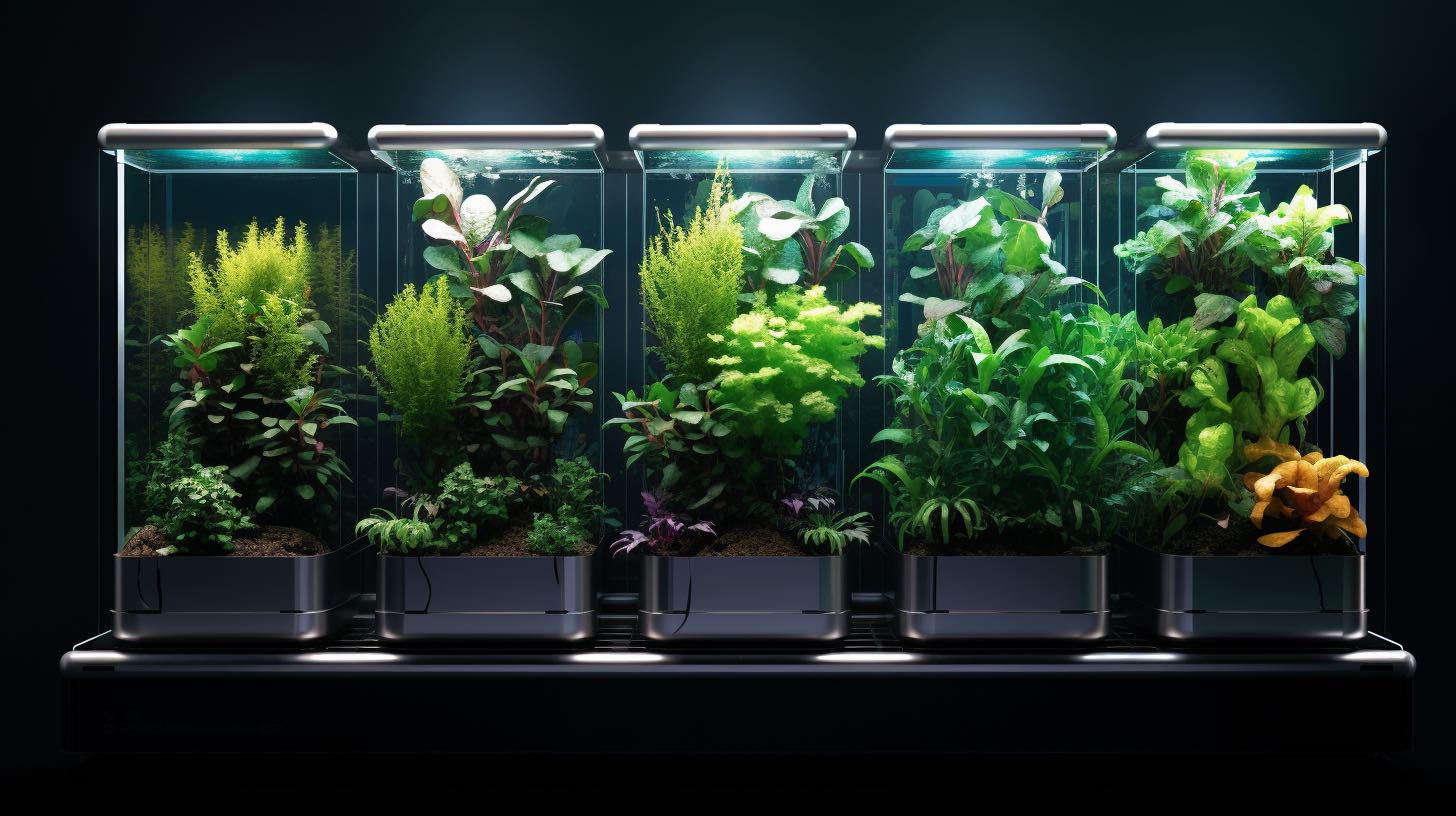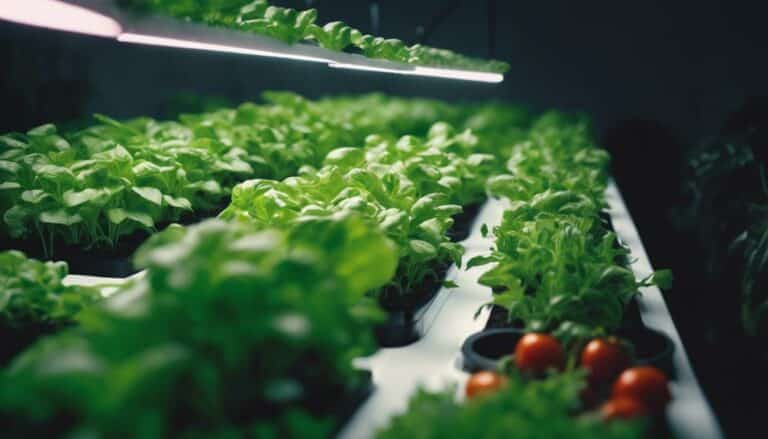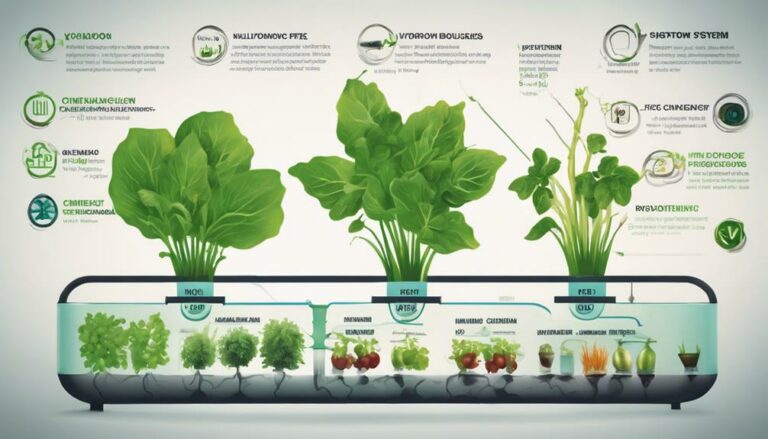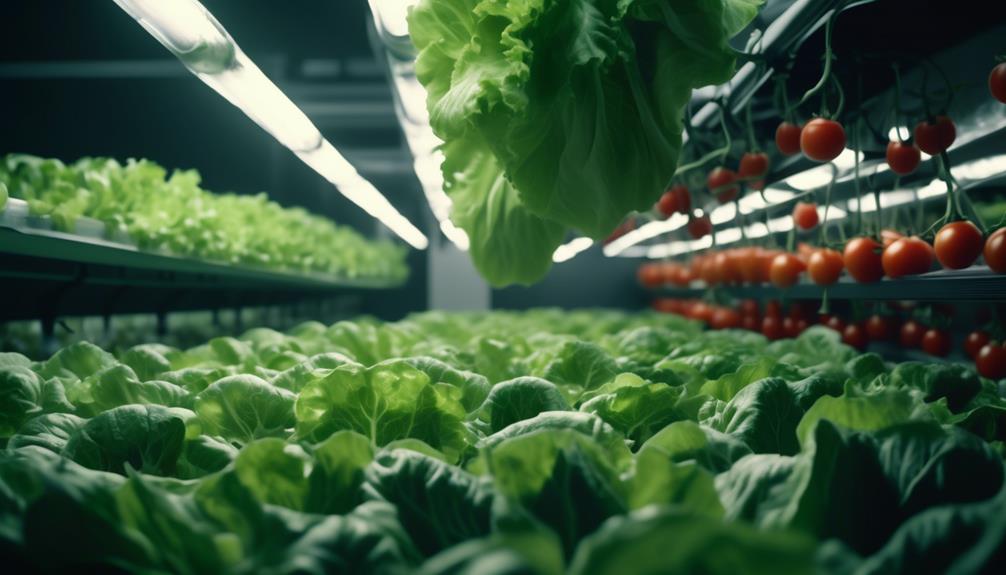Hydroponic systems are like the architects of modern gardening, revolutionizing how plants thrive without soil.
In this article, we will explore the six best hydroponic systems for beginners, providing an informative and detailed overview of each.
From the simplicity of the Kratky Method to the precision of the Aeroponic System, these innovative techniques offer a fresh approach to nurturing plants.
Table of Contents
Whether you’re a novice or an experienced gardener seeking new frontiers, these hydroponic systems are sure to inspire your green thumb.
Key Takeaways
- The Deep Water Culture (DWC) system offers optimal nutrient uptake and plant growth, as well as control over nutrient levels, pH balance, and oxygenation.
- Other hydroponic systems like the Drip Irrigation System and Aeroponic System provide enhanced nutrient delivery, water conservation, and efficient plant nutrient delivery.
- Hydroponic systems are cost-effective, water-conserving, and provide increased plant growth rate and optimal conditions for beginners.
- Considerations for different hydroponic systems include regular maintenance for the Drip Irrigation System, precise nutrient delivery for the Aeroponic System, superior root oxygenation for the High Oxygenation for Roots system, and compact arrangement for systems suitable for small spaces.
Kratky Method
The Kratky Method is a popular hydroponic system that requires minimal equipment and is suitable for beginners. This innovative method eliminates the need for pumps, aerators, and electricity, making it a cost-effective and easy-to-maintain option for aspiring hydroponic gardeners.
The setup process is straightforward, with only a few key steps to follow. First, you’ll need a container filled with a nutrient solution that will provide the necessary nutrients for your plants. Next, place a growing medium, such as perlite or coconut coir, into a net pot and insert your plant’s root system. Finally, submerge the net pot into the nutrient solution, ensuring that the roots are in direct contact with the solution.
The Kratky Method offers several benefits, including water conservation, reduced maintenance, and the ability to grow a wide variety of plants without the need for daily monitoring or adjusting nutrient levels.
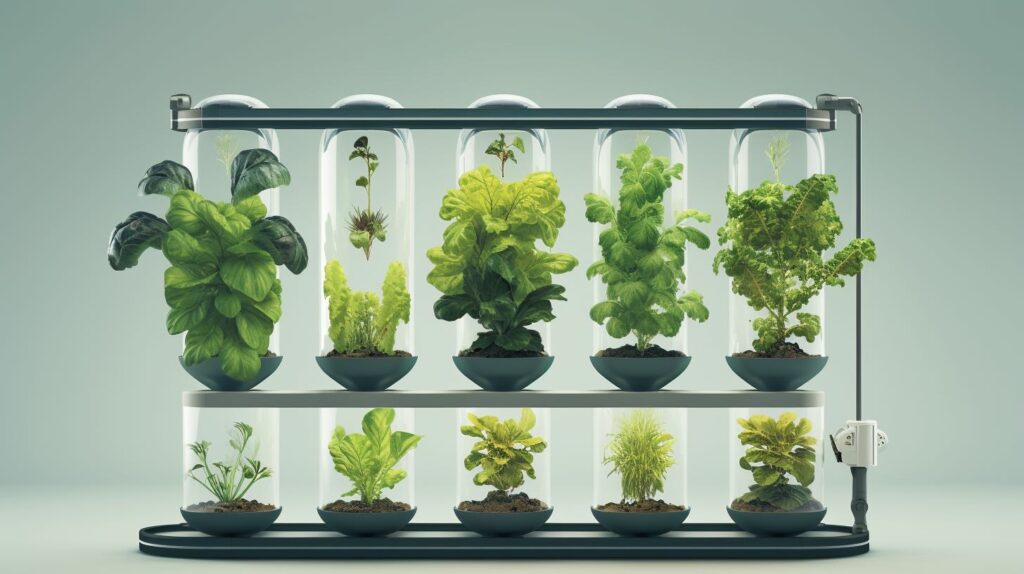
Deep Water Culture
Deep Water Culture (DWC) is a popular hydroponic system that offers several benefits for beginners. With DWC, the plant roots are submerged in a nutrient-rich solution, ensuring constant access to water, oxygen, and nutrients.
Setting up a DWC system requires a few key tips. First, proper aeration is essential to provide enough oxygen to the roots. This can be achieved through the use of air stones or air pumps. Adequate aeration helps prevent root rot and provides the plants with the necessary oxygen for healthy growth.
Second, it is important to monitor pH levels regularly. DWC systems tend to have a higher pH due to the addition of nutrients. Maintaining the pH within the optimal range (typically between 5.5 and 6.5) is crucial for nutrient absorption and overall plant health. pH test kits or meters can be used to measure and adjust the pH levels accordingly.
Lastly, maintaining the right water temperature is crucial for the success of a DWC system. The water temperature should ideally be kept between 65°F and 75°F (18°C and 24°C). This range promotes optimal nutrient uptake and prevents the growth of harmful pathogens.
Benefits of DWC
One major benefit of utilizing the DWC (Deep Water Culture) hydroponic system is its ability to provide optimal nutrient uptake for plants. In a DWC system, plants are suspended in a nutrient-rich solution, allowing for efficient nutrient absorption through their roots. This method ensures that plants have constant access to the necessary nutrients they need for growth and development.
The efficient nutrient absorption in DWC systems leads to an increased plant growth rate. With a continuous supply of nutrients readily available, plants are able to grow at a faster pace compared to traditional soil-based methods. This accelerated growth rate can be particularly advantageous for beginners who are looking to see results quickly and effectively.
Furthermore, the DWC system also allows for better control over nutrient levels, pH balance, and oxygenation, ensuring that plants receive the ideal conditions for optimal growth. The combination of these benefits makes DWC an excellent choice for beginners seeking an innovative and efficient hydroponic system.
DWC Setup Tips
To ensure a successful DWC setup, proper equipment and maintenance are essential. Here are some tips to help you maintain nutrient levels and troubleshoot common issues:
- Monitor nutrient levels regularly:
- Nutrient levels in a DWC system can fluctuate, so it’s crucial to test and adjust them regularly.
- Use a reliable pH meter and nutrient solution to maintain optimal levels for your plants.
- Oxygenate the water:
- Oxygen is vital for the health of the plant roots.
- Ensure that your DWC system has adequate aeration, such as using air stones or diffusers, to oxygenate the water and prevent root rot.
- Keep an eye on water temperature:
- The ideal water temperature for DWC is between 65-75°F (18-24°C).
- High temperatures can lead to nutrient deficiencies and root problems, while low temperatures can slow down plant growth.
- Use a water heater or chiller to maintain the optimal temperature range.
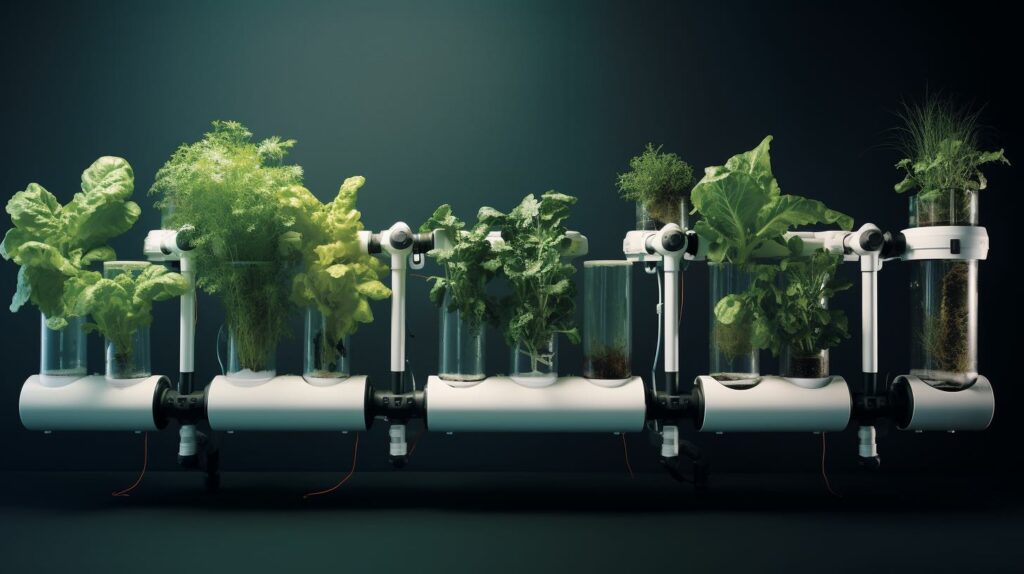
Nutrient Film Technique
When implementing hydroponic systems for beginners, it is crucial to consider the Nutrient Film Technique (NFT). NFT is a popular hydroponic system that involves a thin film of nutrient-rich water flowing over the roots of the plants. One of the key advantages of NFT is its efficient use of water and nutrients. The constant flow of the nutrient solution prevents the roots from becoming waterlogged, ensuring optimal oxygenation for the plants. Additionally, NFT systems are relatively easy to set up and maintain, making them ideal for beginners.
In comparison to the Deep Water Culture (DWC) system, NFT offers a more efficient use of water and nutrients. In DWC, plants are suspended in a nutrient solution, which can lead to stagnant water and poor oxygenation. NFT, on the other hand, provides a continuous flow of nutrients and water, preventing the risk of oxygen deprivation.
Wick System
Continuing the discussion from the previous subtopic, the Wick System is another hydroponic system that is suitable for beginners. This system is simple and requires minimal maintenance, making it ideal for those new to hydroponics.
Here are the pros and cons of the Wick System:
- Pros:
- Easy to set up and use.
- Low cost compared to other hydroponic systems.
- No need for electricity or pumps as the wick passively transports nutrients to the plants.
- Cons:
- Limited to small plants with low nutrient requirements.
- Slow nutrient delivery compared to other systems.
- Risk of overwatering if the wick is too efficient.
When choosing the right wick for your hydroponic setup, consider the following factors:
- Wick material: Cotton, nylon, and polyester are commonly used.
- Wick thickness: Thicker wicks provide better nutrient absorption.
- Wick length: Should be long enough to reach the nutrient solution but not touch the bottom.
Drip Irrigation System
The efficiency of nutrient delivery in hydroponic systems can be enhanced with the use of a Drip Irrigation System. This system delivers water and nutrients directly to the plant roots in a slow and controlled manner. One of the main advantages of a drip irrigation system is its ability to conserve water. By providing water directly to the roots, there is minimal water wastage through evaporation or runoff.
Additionally, this system ensures that plants receive a consistent supply of nutrients, promoting healthy growth. However, there are some drawbacks to consider. Drip irrigation systems can be more expensive to set up compared to other hydroponic systems. They also require regular maintenance to prevent clogging or leaks.
When it comes to choosing plants for drip irrigation, leafy greens, herbs, and fruiting vegetables are recommended, as they thrive with a consistent supply of water and nutrients.
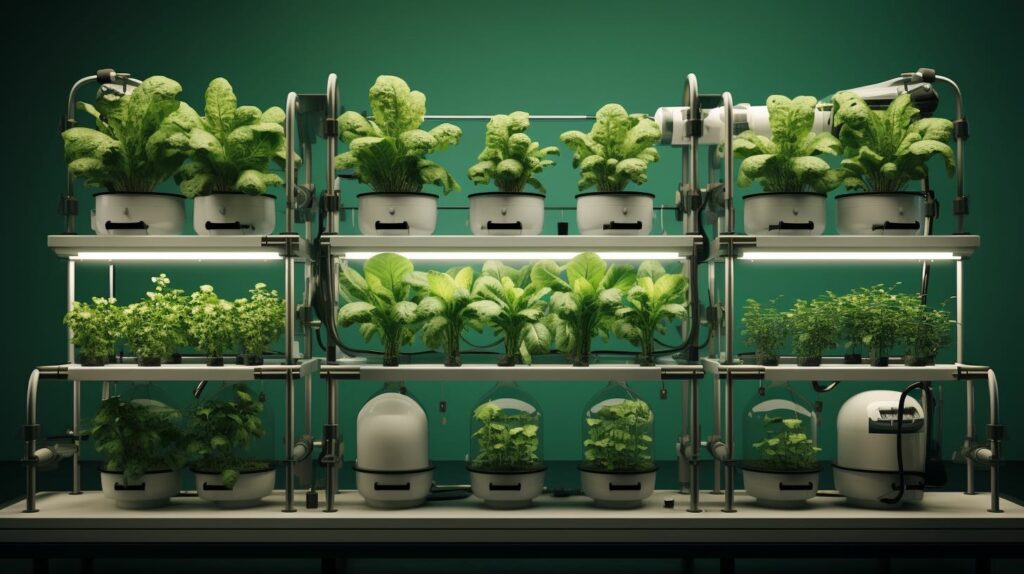
Aeroponic System
The aeroponic system is a highly efficient hydroponic system that delivers plant nutrients directly to the roots. This method ensures that plants receive the necessary nutrients in a precise and controlled manner, leading to optimal growth and productivity.
Additionally, the aeroponic system provides high oxygenation for the roots, promoting healthier plants and faster growth.
It is particularly suitable for small spaces as it requires minimal water and space compared to traditional soil gardening methods.
Efficient Plant Nutrient Delivery
Efficient plant nutrient delivery is a key feature of the aeroponic system, making it an ideal choice for beginner hydroponic gardeners. With this innovative system, hydroponic nutrient solutions are delivered directly to the plant roots in a highly efficient and precise manner.
Here are three ways the aeroponic system optimizes plant growth through efficient nutrient delivery:
- Fine Mist Atomization: The aeroponic system uses high-pressure misters to create a fine mist of nutrient solution. This mist envelops the plant roots, ensuring maximum nutrient absorption and minimizing waste.
- Increased Oxygenation: The aeroponic system provides a highly oxygenated environment for the roots by suspending them in air. This promotes healthy root development and enhances nutrient uptake.
- Enhanced Nutrient Absorption: The fine mist of nutrient solution allows for better nutrient absorption by the plant roots. This results in faster growth, increased yields, and improved overall plant health.
High Oxygenation for Roots
With its focus on creating a highly oxygenated environment for roots, the aeroponic system stands out as an effective solution for maximizing plant growth in hydroponic gardening.
Oxygenation techniques are crucial for root health as they ensure that roots receive an adequate supply of oxygen, which is necessary for nutrient uptake and overall plant development.
In an aeroponic system, plants are suspended in air, and their roots are continuously misted with a nutrient-rich solution. This misting process not only delivers essential nutrients directly to the roots but also exposes them to a high level of oxygen.
By providing roots with an abundant supply of oxygen, the aeroponic system promotes rapid growth, improved nutrient absorption, and enhanced overall plant health.
This innovative system offers beginners a unique opportunity to explore hydroponic gardening while reaping the benefits of superior root oxygenation.
Suitable for Small Spaces
One advantage of the aeroponic system, in addition to its high oxygenation capabilities, is its suitability for small spaces. This makes it an ideal choice for those who are limited in terms of available space for their hydroponic setup.
The aeroponic system is designed to maximize vertical gardening, allowing plants to be grown in a compact and efficient manner. Here are three reasons why the aeroponic system is perfect for small spaces:
- Vertical Gardening: The aeroponic system allows for vertical gardening, which means plants can be grown upward instead of outward. This vertical growth maximizes the use of limited space and allows for a larger number of plants to be grown in a small area.
- Container Gardening: The aeroponic system uses containers to hold the plants and nutrient solution. These containers can be arranged in a compact and organized manner, further optimizing the use of space. Additionally, the containers can be easily moved and rearranged, allowing for flexibility in design and layout.
- Space Efficiency: The aeroponic system is designed to be space-efficient, with its compact design and ability to utilize vertical space. This means that even those with limited space can enjoy the benefits of hydroponic gardening and grow a wide variety of plants without the need for a large garden or outdoor area.
Frequently Asked Questions
Are Hydroponic Systems Suitable for Growing All Types of Plants?
Hydroponic systems are suitable for growing a wide range of plant species. They offer benefits such as precise control over nutrient delivery, efficient water usage, and faster growth rates. This innovative method of cultivation is gaining popularity among those seeking optimal plant growth.
How Often Do Hydroponic Systems Need to Be Monitored and Maintained?
Hydroponic systems require regular monitoring and maintenance to ensure optimal plant growth. The frequency of maintenance depends on factors such as system size, plant type, and environmental conditions. Common issues in hydroponics include nutrient imbalances, pH fluctuations, and pest control.
Can Hydroponic Systems Be Used in Both Indoor and Outdoor Settings?
Hydroponic systems can be used in both indoor and outdoor settings, each with its own pros and cons. Setting up a hydroponic system in an outdoor space requires careful consideration of factors such as climate, sunlight, and pest control.
What Are the Potential Challenges or Drawbacks of Using Hydroponic Systems?
When considering the use of hydroponic systems, it is important to be aware of the potential challenges and drawbacks that may arise. These can include issues related to maintenance, nutrient balance, and initial setup costs.
Is It Necessary to Use Specific Types of Nutrients or Fertilizers in Hydroponic Systems?
Nutrient requirements in hydroponic systems depend on the specific plants being grown. While specific types of nutrients or fertilizers are not necessary, it is important to provide a balanced solution. Organic alternatives can be used to meet these requirements.
Conclusion
In conclusion, these six hydroponic systems provide beginners with a variety of options to start their own indoor gardens. From the Kratky Method’s simplicity to the Aeroponic System’s efficiency, each system offers unique benefits for cultivating plants without soil.
Whether you’re a novice or experienced grower, exploring these hydroponic techniques allows you to embark on a rewarding journey of sustainable and efficient gardening.
So, dive into the world of hydroponics and discover the limitless potential of growing plants in water-based environments!

